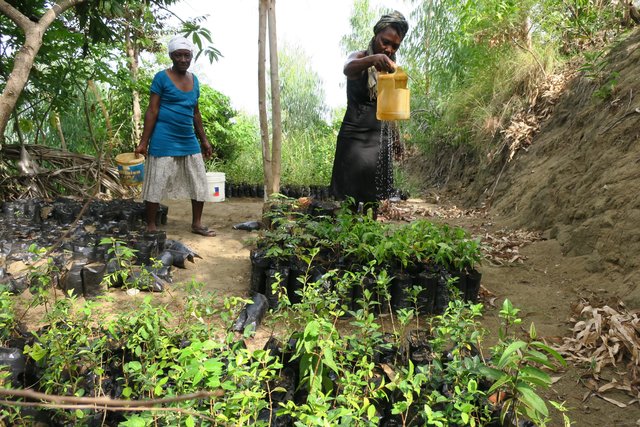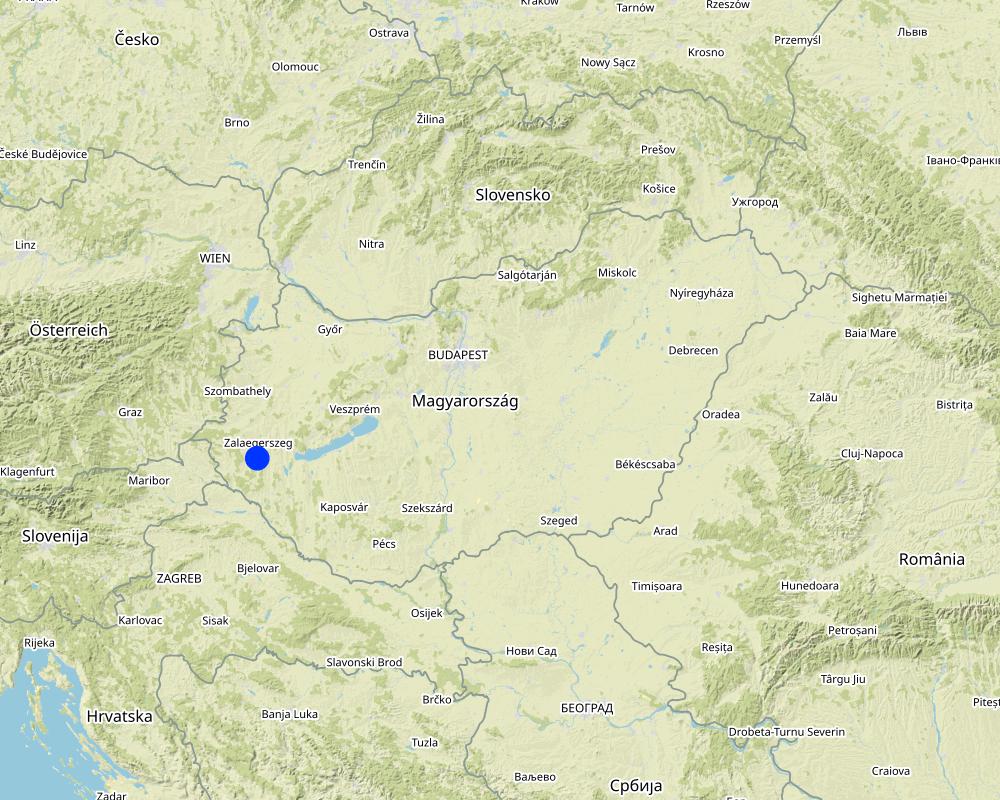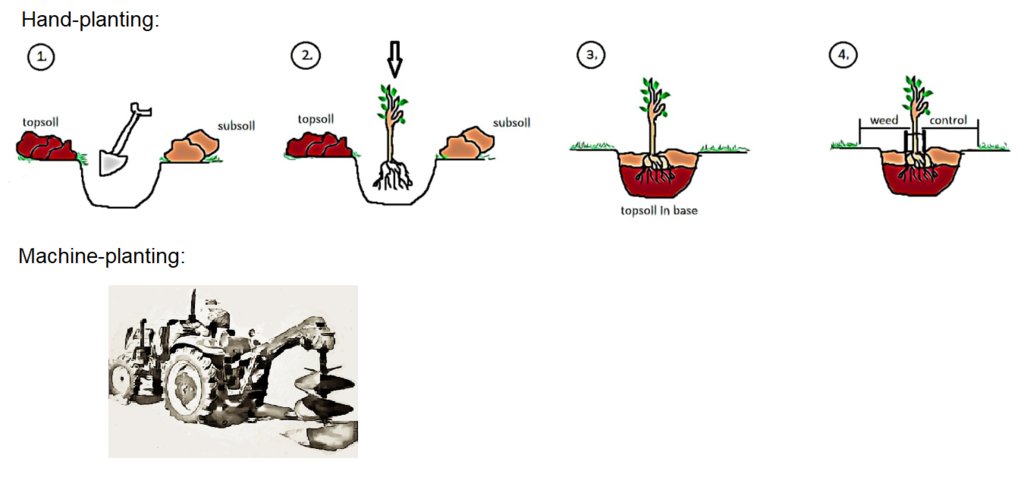Afforestation of arable land [Hungary]
- Creation:
- Update:
- Compiler: Brigitta Szabó
- Editors: Piroska Kassai, Zoltan Toth
- Reviewers: William Critchley, Rima Mekdaschi Studer
Erdőtelepítés
technologies_5930 - Hungary
View sections
Expand all Collapse all1. General information
1.2 Contact details of resource persons and institutions involved in the assessment and documentation of the Technology
Key resource person(s)
SLM specialist:
Name of project which facilitated the documentation/ evaluation of the Technology (if relevant)
OPtimal strategies to retAIN and re-use water and nutrients in small agricultural catchments across different soil-climatic regions in Europe (OPTAIN)1.3 Conditions regarding the use of data documented through WOCAT
The compiler and key resource person(s) accept the conditions regarding the use of data documented through WOCAT:
Yes
1.4 Declaration on sustainability of the described Technology
Is the Technology described here problematic with regard to land degradation, so that it cannot be declared a sustainable land management technology?
No
1.5 Reference to Questionnaire(s) on SLM Approaches (documented using WOCAT)

Afforestation [Haiti]
In the Mornes region of Léogâne, the Swiss Red Cross (SRC) practices reforestation through community participation.
- Compiler: Joana Eichenberger
2. Description of the SLM Technology
2.1 Short description of the Technology
Definition of the Technology:
Afforestation is planting trees on previously non-forested land. Trees hold the soil and reduce runoff, and thus prevent erosion of the most fertile layers. It is an effective way to rehabilitate degraded lands, being a nature-based solution which addresses flood and soil erosion impacts.
2.2 Detailed description of the Technology
Description:
Afforestation is planting trees on previously non-forested land. Trees hold the soil and reduce runoff, and thus prevent erosion of the most fertile layers. It is an effective way to rehabilitate degraded lands, being a nature-based solution which addresses floods and soil erosion. As vegetation cover plays a crucial role in erosion and runoff rates, afforestation is considered among the best options for soil conservation. Water-related forest ecosystem services include the provision, filtration and regulation of water, along with stream ecosystem support and water-related hazard control, for example soil protection from runoff and erosion. In this context, forest management practices that involve vegetation cover modifications may have a substantial impact on the provision of water-related ecosystem services. Moreover, forest ecosystem interactions with water and energy cycles have been highlighted as the foundations for carbon storage, water resources distribution and terrestrial temperature balancing. Forest management may thus play a key role in meeting climate change mitigation goals as well (Rodrigues et al. 2020).
Afforestation is recommended in areas affected by severe erosion, especially where the slope exceeds 17% and deep gully erosion occurs. This can be a whole parcel or only a part of it. Planting mixed forest consisting of indigenous tree species is the most advantageous.
The main steps in planting/ maintaining trees are as follows:
•Site preparation: considerations include the most effective and cost-efficient methods; soil type, existing vegetation, time and financial constraints.
•Planting: machine-planting or hand-planting.
•Follow-up: monitoring survival, continuing control of competing vegetation, providing protection from animal damage, and monitoring for disease and insects.
•Harvesting/thinning: removing individual trees to reduce the woodland density. Through removing poorer quality trees, the stronger thrive.
Although the long-term environmental benefits of afforestation are significant, farmers generally do not like participating in afforestation programmes because it means a significant loss of income in the short/mid-term (even with the available subsidies/agricultural support).
2.3 Photos of the Technology
2.4 Videos of the Technology
Comments, short description:
no video avalilable
Location:
-
Name of videographer:
-
2.5 Country/ region/ locations where the Technology has been applied and which are covered by this assessment
Country:
Hungary
Region/ State/ Province:
Zala County
Further specification of location:
The site where the technology is applied is situated within the catchment of Felső-Válicka stream, which belongs to the Balaton catchment area in western Hungary.
Specify the spread of the Technology:
- evenly spread over an area
If precise area is not known, indicate approximate area covered:
- 0.1-1 km2
Is/are the technology site(s) located in a permanently protected area?
No
Map
×2.6 Date of implementation
If precise year is not known, indicate approximate date:
- 10-50 years ago
2.7 Introduction of the Technology
Specify how the Technology was introduced:
- through land users' innovation
- through projects/ external interventions
3. Classification of the SLM Technology
3.1 Main purpose(s) of the Technology
- reduce, prevent, restore land degradation
- protect a watershed/ downstream areas – in combination with other Technologies
- preserve/ improve biodiversity
- adapt to climate change/ extremes and its impacts
3.2 Current land use type(s) where the Technology is applied
Land use mixed within the same land unit:
No

Cropland
- Annual cropping
Annual cropping - Specify crops:
- cereals - barley
- cereals - maize
- cereals - wheat (winter)
- oilseed crops - sunflower, rapeseed, other
Number of growing seasons per year:
- 1
Is intercropping practiced?
No
Is crop rotation practiced?
Yes
If yes, specify:
wheat-maize-sunflower-barley
3.3 Has land use changed due to the implementation of the Technology?
Has land use changed due to the implementation of the Technology?
- Yes (Please fill out the questions below with regard to the land use before implementation of the Technology)
Land use mixed within the same land unit:
No

Forest/ woodlands
- Tree plantation, afforestation
Tree plantation, afforestation: Specify origin and composition of species:
- Monoculture local variety
- Mixed varieties
Type of tree plantation, afforestation:
- temperate continental forest plantation
Are the trees specified above deciduous or evergreen?
- deciduous
Products and services:
- Protection against natural hazards
3.4 Water supply
Water supply for the land on which the Technology is applied:
- rainfed
3.5 SLM group to which the Technology belongs
- forest plantation management
- improved ground/ vegetation cover
- surface water management (spring, river, lakes, sea)
3.6 SLM measures comprising the Technology

vegetative measures
- V1: Tree and shrub cover

management measures
- M1: Change of land use type
3.7 Main types of land degradation addressed by the Technology

soil erosion by water
- Wt: loss of topsoil/ surface erosion
- Wg: gully erosion/ gullying

biological degradation
- Bh: loss of habitats
- Bq: quantity/ biomass decline

water degradation
- Hs: change in quantity of surface water
- Hp: decline of surface water quality
- Hq: decline of groundwater quality
3.8 Prevention, reduction, or restoration of land degradation
Specify the goal of the Technology with regard to land degradation:
- prevent land degradation
- reduce land degradation
4. Technical specifications, implementation activities, inputs, and costs
4.1 Technical drawing of the Technology
Technical specifications (related to technical drawing):
1. Digging a hole
2. Planting the tree sapling
3. Covering with the soil, inverse back digging is recommended (topsoil in base)
4. Forming a weed free area at least 1 diameter around the tree and using stakes to stabilize the tree.
5. Spacing between trees is depending on tree sizes: at least 2,5 meter between small trees and at least 5 meter between larger trees.
Author:
Piroska Kassai
Date:
15/03/2023
4.2 General information regarding the calculation of inputs and costs
Specify how costs and inputs were calculated:
- per Technology area
Indicate size and area unit:
hectare
Specify currency used for cost calculations:
- USD
Indicate average wage cost of hired labour per day:
50
4.3 Establishment activities
| Activity | Timing (season) | |
|---|---|---|
| 1. | approval process (planning and obtaining permit) | any season |
| 2. | soil preparation | autumn |
| 3. | planting | autumn |
| 4. | wild fence construction | autumn |
4.4 Costs and inputs needed for establishment
| Specify input | Unit | Quantity | Costs per Unit | Total costs per input | % of costs borne by land users | |
|---|---|---|---|---|---|---|
| Labour | soil preparation | person day | 2.0 | 50.0 | 100.0 | 100.0 |
| Labour | planting (4000 seedlings on 1 hectare) | person day | 3.0 | 50.0 | 150.0 | 100.0 |
| Labour | wild fence construction | person day | 4.0 | 50.0 | 200.0 | 100.0 |
| Equipment | soil preparation | hiring cost/day | 1.0 | 400.0 | 400.0 | 100.0 |
| Equipment | planting | hiring cost/day | 1.0 | 100.0 | 100.0 | 100.0 |
| Equipment | wild fence construction | hiring cost/day | 2.0 | 100.0 | 200.0 | 100.0 |
| Plant material | seedlings | piece | 4000.0 | 0.1 | 400.0 | 100.0 |
| Construction material | wild fence raw material | meter | 400.0 | 2.5 | 1000.0 | 100.0 |
| Other | approval process (planning and obtaining permit) | per case | 1.0 | 400.0 | 400.0 | 100.0 |
| Total costs for establishment of the Technology | 2950.0 | |||||
| Total costs for establishment of the Technology in USD | 2950.0 | |||||
Comments:
Subsidies are available for the establisment cost (~2000$/ha)
4.5 Maintenance/ recurrent activities
| Activity | Timing/ frequency | |
|---|---|---|
| 1. | Tillage/mechanical weeding | yearly |
4.6 Costs and inputs needed for maintenance/ recurrent activities (per year)
| Specify input | Unit | Quantity | Costs per Unit | Total costs per input | % of costs borne by land users | |
|---|---|---|---|---|---|---|
| Labour | Tillage/mechanical weeding | person day | 1.0 | 50.0 | 50.0 | 100.0 |
| Equipment | Tillage/mechanical weeding- machine hiring cost | hiring cost/day | 1.0 | 300.0 | 300.0 | 100.0 |
| Total costs for maintenance of the Technology | 350.0 | |||||
| Total costs for maintenance of the Technology in USD | 350.0 | |||||
Comments:
Financial supports are available for the maintanence cost of the forest and for the loss of farm income (in the case of land use change from cropland to forest)
4.7 Most important factors affecting the costs
Describe the most determinate factors affecting the costs:
tree species, existing vegetation, soil type
5. Natural and human environment
5.1 Climate
Annual rainfall
- < 250 mm
- 251-500 mm
- 501-750 mm
- 751-1,000 mm
- 1,001-1,500 mm
- 1,501-2,000 mm
- 2,001-3,000 mm
- 3,001-4,000 mm
- > 4,000 mm
Specify average annual rainfall (if known), in mm:
725.00
Specifications/ comments on rainfall:
Distribution of precipitation is uneven
Agro-climatic zone
- sub-humid
5.2 Topography
Slopes on average:
- flat (0-2%)
- gentle (3-5%)
- moderate (6-10%)
- rolling (11-15%)
- hilly (16-30%)
- steep (31-60%)
- very steep (>60%)
Landforms:
- plateau/plains
- ridges
- mountain slopes
- hill slopes
- footslopes
- valley floors
Altitudinal zone:
- 0-100 m a.s.l.
- 101-500 m a.s.l.
- 501-1,000 m a.s.l.
- 1,001-1,500 m a.s.l.
- 1,501-2,000 m a.s.l.
- 2,001-2,500 m a.s.l.
- 2,501-3,000 m a.s.l.
- 3,001-4,000 m a.s.l.
- > 4,000 m a.s.l.
Indicate if the Technology is specifically applied in:
- not relevant
5.3 Soils
Soil depth on average:
- very shallow (0-20 cm)
- shallow (21-50 cm)
- moderately deep (51-80 cm)
- deep (81-120 cm)
- very deep (> 120 cm)
Soil texture (topsoil):
- medium (loamy, silty)
- fine/ heavy (clay)
Soil texture (> 20 cm below surface):
- medium (loamy, silty)
- fine/ heavy (clay)
Topsoil organic matter:
- medium (1-3%)
5.4 Water availability and quality
Ground water table:
5-50 m
Availability of surface water:
good
Water quality (untreated):
poor drinking water (treatment required)
Water quality refers to:
surface water
Is water salinity a problem?
No
Is flooding of the area occurring?
Yes
5.5 Biodiversity
Species diversity:
- high
Habitat diversity:
- high
5.6 Characteristics of land users applying the Technology
Sedentary or nomadic:
- Sedentary
Market orientation of production system:
- commercial/ market
Off-farm income:
- less than 10% of all income
Relative level of wealth:
- rich
Individuals or groups:
- individual/ household
Level of mechanization:
- mechanized/ motorized
Gender:
- men
Age of land users:
- elderly
5.7 Average area of land used by land users applying the Technology
- < 0.5 ha
- 0.5-1 ha
- 1-2 ha
- 2-5 ha
- 5-15 ha
- 15-50 ha
- 50-100 ha
- 100-500 ha
- 500-1,000 ha
- 1,000-10,000 ha
- > 10,000 ha
Is this considered small-, medium- or large-scale (referring to local context)?
- large-scale
5.8 Land ownership, land use rights, and water use rights
Land ownership:
- company
Land use rights:
- leased
- individual
Water use rights:
- communal (organized)
Are land use rights based on a traditional legal system?
Yes
5.9 Access to services and infrastructure
health:
- poor
- moderate
- good
education:
- poor
- moderate
- good
technical assistance:
- poor
- moderate
- good
employment (e.g. off-farm):
- poor
- moderate
- good
markets:
- poor
- moderate
- good
energy:
- poor
- moderate
- good
roads and transport:
- poor
- moderate
- good
drinking water and sanitation:
- poor
- moderate
- good
financial services:
- poor
- moderate
- good
6. Impacts and concluding statements
6.1 On-site impacts the Technology has shown
Socio-economic impacts
Production
crop production
Comments/ specify:
Crop production is not possible in afforested areas, but financial support is available to compensate for the loss of income
wood production
Comments/ specify:
Wood production for industrial or energy purposes is possible in an afforested area, which also generates significant income
product diversity
Income and costs
farm income
Comments/ specify:
Farm income may decrease but financial compensatory supports are available in the afforestation programs.
diversity of income sources
Ecological impacts
Water cycle/ runoff
water quality
surface runoff
Soil
soil moisture
Comments/ specify:
As trees have a larger leaf area, surface roughness and deeper rooting systems than grassland or cropland, afforestation could usually result in reduced soil moisture content.
soil loss
Comments/ specify:
The density of the vegetation cover greatly influences the degree of soil loss reduction
nutrient cycling/ recharge
soil organic matter/ below ground C
acidity
Comments/ specify:
Especially under coniferous forests soil acidity increases, but this only matters if cropland use would be planned again on the area in the future
Biodiversity: vegetation, animals
Vegetation cover
animal diversity
habitat diversity
Climate and disaster risk reduction
flood impacts
landslides/ debris flows
drought impacts
emission of carbon and greenhouse gases
fire risk
wind velocity
micro-climate
Comments/ specify:
Under trees reduced solar radiation, a more moderate temperature regime, higher humidity can be observed.
6.2 Off-site impacts the Technology has shown
water availability
groundwater/ river pollution
buffering/ filtering capacity
wind transported sediments
Comments/ specify:
Trees as physical barriers can significantly decrease wind erosion
impact of greenhouse gases
6.3 Exposure and sensitivity of the Technology to gradual climate change and climate-related extremes/ disasters (as perceived by land users)
Gradual climate change
Gradual climate change
| Season | increase or decrease | How does the Technology cope with it? | |
|---|---|---|---|
| annual temperature | increase | well | |
| seasonal temperature | summer | increase | moderately |
| seasonal rainfall | summer | decrease | moderately |
Climate-related extremes (disasters)
Meteorological disasters
| How does the Technology cope with it? | |
|---|---|
| local rainstorm | well |
| local windstorm | moderately |
Climatological disasters
| How does the Technology cope with it? | |
|---|---|
| heatwave | moderately |
| extreme winter conditions | well |
| drought | moderately |
| forest fire | not well at all |
Hydrological disasters
| How does the Technology cope with it? | |
|---|---|
| landslide | moderately |
Biological disasters
| How does the Technology cope with it? | |
|---|---|
| insect/ worm infestation | moderately |
6.4 Cost-benefit analysis
How do the benefits compare with the establishment costs (from land users’ perspective)?
Short-term returns:
negative
Long-term returns:
neutral/ balanced
How do the benefits compare with the maintenance/ recurrent costs (from land users' perspective)?
Short-term returns:
slightly negative
Long-term returns:
neutral/ balanced
6.5 Adoption of the Technology
- 1-10%
Of all those who have adopted the Technology, how many did so spontaneously, i.e. without receiving any material incentives/ payments?
- 0-10%
6.6 Adaptation
Has the Technology been modified recently to adapt to changing conditions?
No
6.7 Strengths/ advantages/ opportunities of the Technology
| Strengths/ advantages/ opportunities in the land user’s view |
|---|
| Reduce soil erosion |
| Strengths/ advantages/ opportunities in the compiler’s or other key resource person’s view |
|---|
| Reduce carbon emission |
| Reduce soil erosion and groundwater pollution |
| Improves microclimate |
6.8 Weaknesses/ disadvantages/ risks of the Technology and ways of overcoming them
| Weaknesses/ disadvantages/ risks in the land user’s view | How can they be overcome? |
|---|---|
| Loss of crop yield, loss of income | |
| The appearance of wild animals in agricultural area improves the risk of crop damage on the surrounding croplands | Building fences |
7. References and links
7.1 Methods/ sources of information
- field visits, field surveys
2
- interviews with land users
2
- interviews with SLM specialists/ experts
1
When were the data compiled (in the field)?
26/10/2022
7.2 References to available publications
Title, author, year, ISBN:
Special Issue "Afforestation and Reforestation: Drivers, Dynamics, and Impacts" in Forests (ISSN 1999-4907).
Available from where? Costs?
https://www.mdpi.com/journal/forests/special_issues/afforestation_reforestation
Title, author, year, ISBN:
Rodrigues, A.R., Botequim, B., Tavares, C. et al. Addressing soil protection concerns in forest ecosystem management under climate change. For. Ecosyst. 7, 34 (2020)
Available from where? Costs?
https://doi.org/10.1186/s40663-020-00247-y
7.3 Links to relevant online information
Title/ description:
European NWRM platform
URL:
nwrm.eu
Title/ description:
Creating a forest: A step by step guiding
URL:
https://erc.cals.wisc.edu/woodlandinfo
7.4 General comments
-
Links and modules
Expand all Collapse allLinks

Afforestation [Haiti]
In the Mornes region of Léogâne, the Swiss Red Cross (SRC) practices reforestation through community participation.
- Compiler: Joana Eichenberger
Modules
No modules






